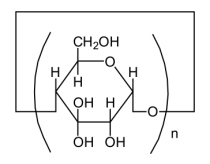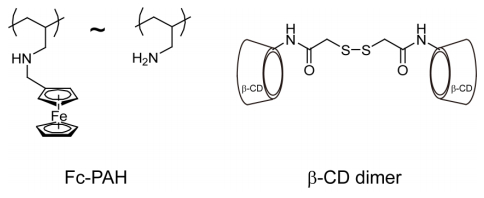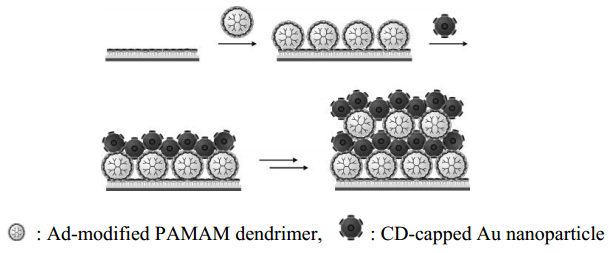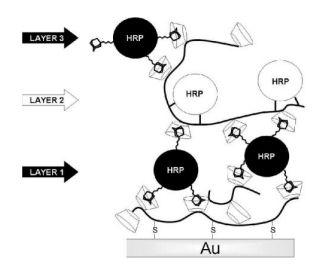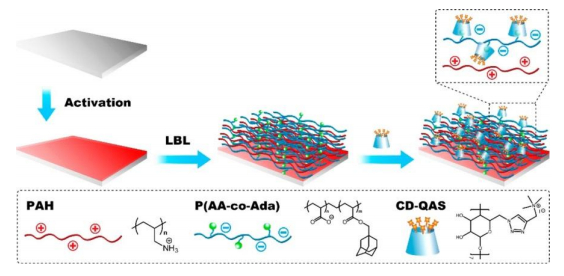1. Introduction
The development of layer-by-layer (LbL) films and microcapsules has been a key subject in polymer science and technology [1,2,3,4,5]. LbL films are prepared by the successive deposition of polymeric materials on the surface of solid substrates, such as metals, glass, and polymers, through attractive forces, including electrostatic interactions, hydrogen bonding, and biological affinity. Thus, a variety of synthetic and biological materials can be used as components of LbL assemblies. LbL assemblies are characterized by well-defined stratified structures containing the polymeric materials.
LbL films can be prepared from a cationic and an anionic polymer through the electrostatic affinity between them. The adsorption of charged polymers on an oppositely charged surface produces a new surface with the opposite charge, resulting from overcompensation of the surface charge. The over-compensated surface enables the deposition of the next layer of an oppositely charged polymer. In a typical procedure, the solid substrate is alternately immersed in aqueous solutions of the polymers, followed by rinsing to remove nonspecifically or weakly adsorbed polymers (Figure 1a). The thickness of the film can be regulated simply by changing the number of deposited layers, because film thickness increases with the number of depositions. Biopolymers, such as proteins [6,7], polysaccharides [8,9], and DNA [10,11], can also be used as building blocks for constructing LbL films, because these biopolymers contain net electric charges.
Hydrogen bonding can also be used as a driving force for constructing LbL films. Poly(acrylic acid) (PAA) and poly(methacrylic acid) (PMA) are often used as hydrogen bonding donor polymers in combination with hydrogen bonding acceptors, such as poly(ethylene glycol) [12,13]. An interesting feature of hydrogen-bonded LbL films is their pH-dependent stability. LbL films consisting of PAA and PMA are stable in acidic solutions, whereas these films decompose in neutral and basic media because the hydrogen bonds are broken via deprotonation of the carboxylic acid residues. Proteins can also be used as components of LbL films, in which film formation relies on biological affinity. For example, concanavalin A and avidin, which specifically bind sugars and biotin, respectively, are used to construct LbL films [14,15,16].
Hollow microcapsules can be constructed by LbL deposition of polymers on the surfaces of colloidal particles, such as CaCO3 microspheres, followed by dissolution of the core (Figure 1b). These polymer microcapsules are stable over a wide pH range. Therefore, LbL microcapsules are being widely studied as drug carriers [17,18,19]. An advantage of LbL microcapsules is that the structure of their shell membrane can be tailored at the molecular level by using suitable materials. LbL films and microcapsules have been used in applications such as separation and purification membranes [20,21], optical and electrochemical sensors [22,23], drug delivery systems [24,25], and self-healing gels [26,27].
Recently, much attention has been devoted to constructing cyclodextrin (CD)-containing LbL assemblies and their use in biosensing and drug delivery. CDs are naturally occurring cyclic oligosaccharides composed of D-glucose units linked with α-1, 4-glucosidic bonds. α-CD, β-CD, and γ-CD, which consist of six, seven, and eight D-glucose units, respectively, have been widely used and are currently commercially available (Figure 2). CDs bind low-molecular-weight compounds in their hydrophobic cavity to form host–guest inclusion complexes [28,29,30] and are non-toxic; thus, CDs are used in foods, cosmetics, and drugs as solubilizers or stabilizers [31,32,33]. Furthermore, CDs have been used as molecular recognition elements in constructing devices for biosensing and drug delivery [34,35,36,37], in which CDs are immobilized in polymer matrices such as thin films and gels. Consequently, the preparation of CD-containing polymer matrices is a key step in the development of high-performance CD-based devices.
This paper gives an overview of CD-containing thin films and microcapsules prepared by LbL deposition. The strategies used in the synthesis of these assemblies and their biomedical applications are discussed.
2. Synthesis of CD-containing LbL Assemblies
There are two types of synthetic strategy for CD-containing LbL assemblies based on the type of driving force used for assembly. The first strategy is to use charged CDs, and the LbL assemblies are prepared through electrostatic affinity. In this protocol, charged CDs, such as sulfonated CDs, are used as film components in combination with positively charged polymers. Sulfonated CDs are currently commercially available. The second strategy for constructing CD-containing LbL assemblies relies on the host–guest complexation between CD and guest molecules as a driving force for assembly. In this route, CD polymers and guest molecule-appended polymers are built into LbL layers by forming host–guest complexes. CD-capped nanoparticles are also useful as components of LbL assemblies in this protocol.
2.1. LbL Assemblies Prepared by Using Charged CDs
The first example of CD-containing LbL films was reported by Swanson and coworkers [38]. They used α-CD substituted with sulfonate groups (s-α-CD, Figure 3) to prepare LbL films by alternate deposition of the s-α-CD with poly(diallyldimethylammonium chloride) (PDDA). The s-α-CD/PDDA films were tested as a sensitive layer in surface acoustic wave sensors for measuring volatile organic compounds (VOCs). However, full experimental details for the preparation of the s-α-CD/PDDA films were not provided.
Later, our group prepared LbL films containing s-α-CD and s-β-CD (Figure 3), which contain nominally 12 and 14 sulfonate groups in a single molecule, by alternate deposition of the sulfonated CDs with poly(allylamine hydrochloride) (PAH) [39,40]. A quartz crystal microbalance (QCM) study showed that the sulfonated CDs and PAH form LbL films through electrostatic affinity. The loading of CDs in the films depended strongly on the ionic strength of the bathing solutions from which the CDs and PAH were deposited. Thus, LbL films prepared using CDs and PAH solutions with higher ionic strength allowed thicker films that contained higher amounts of CDs. The thickness of the (s-α-CD/PAH)10 and (s-β-CD/PAH)10 films prepared from water solution without salts was typically 22 and 23 nm, respectively, while the film thickness was more than 10-times higher when the films were prepared from buffer solutions containing 140 mM NaCl. Interestingly, methyl orange (Figure 3) formed inclusion complexes with s-α-CD in the s-α-CD/PAH film, whereas no inclusion complex formed in the s-β-CD/PAH film. Instead, methyl orange formed aggregations in the s-β-CD/PAH film as a result of electrostatic binding to the positive sites in the film. These results demonstrated that the binding ability of CDs can be preserved, even in the LbL films. LbL films consisting of azobenzene-bearing PAH (Az-PAH, Figure 3) and sulfonated CDs were also prepared through electrostatic affinity [41]. The UV-visible absorption spectrum of the s-α-CD/Az-PAH film contained an absorption maximum at 335 nm originating from the π–π* transition of the azobenzene residues, whereas the absorption maximum was at 326 nm for the s-b-CD/Az-PAH film. The results were explained by the formation of an inclusion complex between azobenzene residues and s-α-CD in the film.
Carboxymethylated β-CD (CM-β-CD) has also been used for constructing LbL films [42]. Negatively charged CM-β-CD and positive polymer diazoresin were alternately deposited to form LbL films on a quartz slide, followed by photochemical crosslinking of CM-β-CD and diazoresin in the film. This process provided covalently crosslinked LbL films containing CD moieties. The CM-β-CD-containing LbL films showed strong binding to the cationic dye methylene blue through host–guest complexation.
Recently, Kim and coworkers synthesized cationic and anionic β-CD oligomers and tried to use them for constructing LbL films [43]. However, film construction failed, probably due to the limited numbers of ionic sites in the β-CD oligomers. On the other hand, polyrotaxanes (PRXs) consisting of cationic and anionic α-CDs were synthesized to construct LbL microcapsules [44]. The alternate deposition of PRXs comprising cationic and anionic α-CDs on the surface of silica (SiO2) microspheres followed by dissolution of the SiO2 core provided hollow microcapsules. The microcapsules disintegrated in response to glutathione (GSH). This result was ascribed to GSH-induced decomposition of the PRXs, which arose from the cleavage of disulfide bonds in the rotaxanes by GSH. The PRXs-based microcapsules may be useful in the development of drug delivery systems because the decomposition products of the microcapsules (i.e., CDs and polyethylene glycol) are biocompatible.
2.2. LbL Assemblies Prepared through Host–guest Complexation
Another route for constructing CD-containing LbL assembly relies on the formation of host–guest inclusion complexes as the driving force. Suzuki and coworkers reported the first example of LbL films prepared through host–guest complexation by using ferrocene-bearing PAH (Fc-PAH) and a disulfide-linked β-CD dimer (Figure 4) [45]. It was anticipated that Fc-PAH chains could be crosslinked with the β-CD dimer to form LbL films. In fact, the QCM study showed that the alternate deposition of Fc-PAH and the β-CD dimer provided a (Fc-PAH/β-CD dimer)3 film. A critical role of the host–guest complexation between the ferrocene moiety of Fc-PAH and β-CD dimer in the film formation was confirmed by the fact that the LbL film did not form when the deposition was carried out with unmodified PAH instead of Fc-PAH or with monomeric β-CD instead of the dimer. Furthermore, no LbL film was obtained when the deposition was performed in the presence of competitive binders to the β-CD dimer, such as ferrocenecarboxylic acid and cyclohexanol.
Polymeric CDs can also be used to construct LbL films. For instance, chitosan derivatives modified with β-CD (CD-Chi) or adamantane (Ad-Chi) were used as host and guest polymers, respectively [46]. The alternate deposition of these chitosan derivatives provided multilayer films by forming host–guest complexes, overcoming electrostatic repulsion between positive charges in the chitosan derivatives. The binding force between CD-Chi and Ad-Chi was evaluated by direct force measurements with an atomic force microscope [47]. The thicker LbL films comprising charged polymers were rather unstable due to the electrostatic repulsion between the polymers. To stabilize LbL films, poly(acrylamide) (PAAm) derivatives modified with ferrocene and β-CD, which bear no electric charge, were used as film components [48]. The PAAm-based films were deposited up to the 30th layer by avoiding electrostatic repulsion in the film. LbL films comprising well-ordered chromophores have been prepared by using perylene diimide derivatives containing β-CD (CD-PDI) or Ad (Ad-PDI) [49]. CD-PDI and Ad-PDI chromophores were linked with each other through host–guest interactions to form LbL layers.
An advantage of LbL deposition is the wide choice of film components, including carbon nanomaterials [50,51] and metal nanoparticles [52,53]. CD-capped Au nanoparticles were used to prepare an LbL assembly through host–guest complexation [54,55] (Figure 5). LbL deposition of the CD-capped Au nanoparticles and Ad-modified poly(amidoamine) (PAMAM) dendrimer gave well-defined multilayer films. CD-capped poly(styrene) nanoparticles were also useful for constructing LbL microcapsules by combining with Fc-modified poly(ethyleneimine) [56]. These microcapsules were decomposed by a competitive binder, such as Ad, suggesting that they could be used as a microcontainer for controlled release.
3. Applications of CD-containing LbL Assemblies
3.1. Optical and Electrochemical Sensors
Polymer films have widely been studied as surface coatings sensitive to ions and molecules for constructing optical, gravimetric, and electrochemical devices [57,58,59,60]. Polymer films can be prepared by various techniques, including physical adsorption, crosslinking, dip-coating, drop-casting, and photo-and electro-polymerization. The conventional protocols for constructing polymer films do not have a mechanism to regulate the fine structure of the polymer films and their thickness at the molecular level. In contrast, LbL deposition can optimize the response characteristics of biosensors by designing suitable parameters, such as the amounts of active ingredients and the thickness of the films [61,62,63,64].
A quartz slide was coated with an LbL-deposited s-β-CD/PAH film to develop fluorescence sensors for lithocholic acid (LA) [65]. The 10-bilayer (s-b-CD/PAH)10 film was doped with the organic dye neutral red (NR) by host–guest complexation. The fluorescence of NR was greatly increased by being included in the s-β-CD cavity in the film. In contrast, the fluorescence intensity decreased in response to LA as a result of competitive binding of LA to s-β-CD, which expelled NR from the s-β-CD cavity. The (s-b-CD/PAH)10 film-coated sensor could detect LA in the concentration range of 1–60 mM.
Au electrodes were coated with LbL films consisting of β-CD-capped Au nanoparticles (β-CD-AuNP) and iron(Ⅲ) tetra-(N-methyl-4-pyridyl)porphyrin (FeTMPyP) to construct electrochemical sensors for dissolved O2 [66,67]. FeTMPyP catalyzed the reduction of dissolved O2 in the range of 0.2–6.5 mg·L–1. Notably, the catalytic activity of the β-CD-AuNP/FeTMPyP film remained unchanged during 200 successive measurements of 6.5 mg·L–1 O2 in buffer solution, demonstrating the high stability of the film. This sensor may be useful as an alternative to Clark O2 sensors. Anticancer drug-loaded silica particles coated with LbL films composed of CD-bearing hyaluronic acid and porphyrin derivative have also been reported [68]. The LbL film-coated silica particles were useful for fluorescence imaging and photodynamic cancer therapy.
Electronic nose systems comprising LbL films of β-CD were developed by using LbL film-coated interdigitated electrodes [69,70]. Chemically modified b-CDs and their polymers were combined with reduced graphene oxide or carbon nanotubes to produce conductive LbL films on the electrodes. The changes in the electric resistance of the LbL films were measured as a function of various volatile organic compounds (VOCs) including methanol, ethanol, propanol, isopropanol, formaldehyde, acetone, benzene, toluene, and p-xylene. The sensors prepared from amino-and diamino-modified b-CDs exhibited a high selectivity for polar protic compounds, whereas benzyl-substituted b-CD-based sensors were selective for non-polar VOCs. A potential use of the electronic nose systems for diagnosis of lung cancers was suggested because some VOCs are biomarkers of lung cancer. Analyzing VOC profiles in exhaled breath with pattern recognition algorithms may allow diagnosis of lung cancer.
Protein-based biosensors are currently widespread as analytical tools in biomedical laboratories and hospitals. Negatively charged s-β-CD and myoglobin (Mb) were used to construct electrochemical biosensors for O2 and H2O2 [71]. s-β-CD/Mb LbL films were prepared on the surface of electrodes through electrostatic affinity. The s-b-CD/Mb film-modified electrodes exhibited electrocatalytic activity for the reduction of O2 and H2O2 owing to the heme Fe(Ⅲ)/Fe(Ⅱ) redox couple in Mb. In other works, horseradish peroxidase (HRP) was immobilized on an electrode surface to construct enzyme biosensors for H2O2, in which Ad-modified HRP (Ad-HRP) and β-CD-bearing carboxymethylcellulose (β-CD-CMC) were used to construct LbL layers [72] (Figure 6). The biosensor exhibited a linear response to H2O2 in the concentration range of 1.0 × 10–4–3.9 × 10–3 M with a detection limit of 2.0 × 10–6 M. The H2O2 sensors were stable, retaining 96% activity of their original response after 30 days storage in a phosphate buffer at pH = 7.0. β-CD-bearing PAMAM dendrimer was also used instead of β-CD-CMC to construct H2O2 sensors [73].
Antibacterial surfaces are crucial in the development of biomedical devices, such as biosensors, drug delivery systems, and artificial organs. A variety of protocols for preparing antibacterial coatings have been studied, including LbL deposition [74]. Recently, CD-containing LbL films have been used for preparing antibacterial coatings, in which b-CD modified with quaternary ammonium residues was incorporated in polyamine LbL films [75,76]. The CD-containing films killed more than 95% of the attached pathogenic bacteria (Figure 7). The dead bacteria could be removed from the surface by immersing the film in surfactant solution and the antibacterial surface was regenerable. It was also reported that LbL films composed of β-CD-bearing PEI and Fc-modified chitosan suppressed bacterial adhesion [77].
3.2. Controlled Release Systems
Hollow microcapsules can be prepared by LbL deposition on the surface of microparticles followed by dissolution of the core particles (Figure 1b). It is noted here that CD-containing microcapsules are satisfactorily stable during the core dissolution probably due to the multi-point binding between CD-and guest-modified polymers. These microcapsules can accommodate drugs in the cavity or the shell. LbL film-based microcapsules can be prepared from a broad range of shell materials. Thus, CD-containing microcapsules are valuable as drug carriers because CDs can form host–guest complexes.
Several groups reported the preparation of LbL film-based microcapsules through host–guest complexation. LbL microcapsules prepared with Fc-[78] and Ad-modified polymers [79,80] exhibited pH-dependent permeability to model drugs, whereas the microcapsule shell made of azobenzene polymers [81,82] was photosensitive. The diameters of these microcapsules are typically 5–10 μm, which depends on the size of core particles used. Consequently, these microcapsules may be suitable for controlled drug release triggered by pH changes and photoirradiation, because the nanostructures of the films can be altered by the external stimuli. In the extreme case, LbL microcapsules may decompose upon exposure to the stimuli, resulting in a burst release of encapsulated drugs.
Biodegradable microcapsules containing anticancer drug paclitaxel (PTX) were prepared through electrostatic affinity between β-CD-bearing hyaluronic acid and poly(L-lysine) [83] (Figure 8). Notably, the microcapsules bind specifically to breast cancer cells (MDA-MB-231) through the hyaluronic acid receptor overexpressed on the cancer cells, decreasing the viability of cancer cells due to the increased local concentration of PTX.
Hydrophobic drugs with poor solubility can be solubilized in water through forming host–guest complexes with CDs [84,85,86]. Thus, encapsulating hydrophobic drugs into LbL microcapsules may be a promising way to control the release of hydrophobic drugs. β-CD complexes of coumarin and Nile red were encapsulated as model drugs into LbL microcapsules [87]. To construct the coumarin-and Nile red-containing microcapsules, β-CD complexes of coumarin or Nile red were loaded on CaCO3 microparticles, and then the microparticles were coated with poly(styrene sulfonate) and PAH layers. Hollow microcapsules were obtained by dissolving the CaCO3 core, leaving β-CD complexes of coumarin or Nile red in the cavity. The release rate of the model drugs from the microcapsules depended on the pH of the medium.
LbL films deposited on the surfaces of flat substrates and microspheres are also useful as drug carriers for controlled release. Various types of LbL films have been combined with CDs to exploit their host–guest complexation. For instance, polyanionic β-CD synthesized by crosslinking b-CD with citric acid was deposited on the surface of a polyethylene terephthalate textile to form LbL coatings [88,89]. The LbL coatings can take up 4-tert-butylbenzoic acid (TBBA), as a model drug, through β-CD complexation. The release of TBBA from the LbL coatings depended on the number of layers in the film. In another study, poly(acrylonitrile) membranes were used as substrates for LbL film coatings [90,91]. LbL films were prepared by using cationic and anionic β-CD polymers synthesized by epichlorohydrin crosslinking. The antibacterial and antifungal drug triclosan was loaded on the LbL film through complexation with the β-CD polymers and the release profile was studied.
Biodegradable nanoparticles, such as poly(lactic acid/glycolic acid) and poly(lactic acid) (PLA) nanoparticles, are versatile carriers for drug delivery systems [92,93]. PLA nanoparticles were coated with LbL films consisting of cationic and anionic β-CD polymers [94]. The lipophilic model drug benzophenone (BP) was loaded on the LbL coatings through host–guest complexation to control the release rate. The release rate of BP was controlled based on the partition equilibrium between free BP and BP included in the β-CD cavity. These examples demonstrate the potential use of CD-containing LbL films and microcapsules for the controlled release of drugs, especially of poorly soluble hydrophobic drugs. Recently, self-healing properties of CD-containing LbL films have been reported by Ge and coworkers [95,96]. These LbL films may be useful for future applications in the development of controlled release systems.
4. Conclusion
CD-containing LbL films and microcapsules have been synthesized by using electrostatic affinity or host–guest complexation as driving forces. In the former route, charged CDs are used as film components in combination with oppositely charged polymers. In contrast, CD polymers and guest molecule-modified polymers are used in the latter route. In most cases, CDs can still bind to guest compounds to form inclusion complexes in LbL assemblies. Biosensors and controlled release systems have been developed by exploiting the binding ability of CDs in the films and microcapsules. CD-containing LbL film-coated electrodes are useful for constructing electrochemical biosensors that detect small molecules such as VOCs, O2, and H2O2. In addition, CD-containing LbL assemblies are useful as drug carriers for controlled release. Hydrophobic, poorly soluble drugs can be loaded on CD-containing LbL films and microcapsules to develop controlled delivery systems. A major advantage of LbL films is that the amount of CD can be controlled precisely by changing the number of layers in the film, which enables the performance characteristics of CD-containing LbL assemblies to be regulated. β-CD is the most widely used CD in LbL assemblies, but the use of α-and γ-CDs would also be promising because these CDs exhibit binding selectivity different from that of β-CD. Furthermore, modified CDs that contain substituents, such as methyl, acetyl, and hydroxypropyl groups, may be useful for the future development of CD-containing LbL assemblies.
Conflict of Interest
The authors declare no conflict of interest.









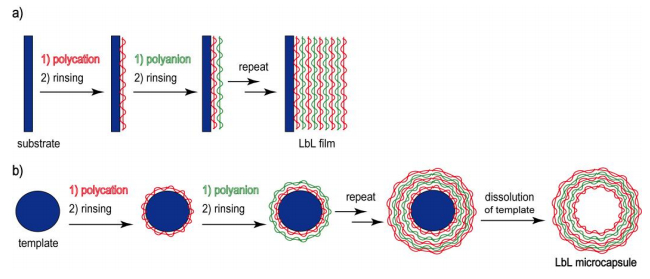
 DownLoad:
DownLoad: 